
CHAPTER 6
MAKE JUICE, NOT WAR
If you really want to get into the sparkle zone, you gotta get gaga for liquid nutrition! Organic green juice is like red lipstick; don’t leave home without it. Juice is the muse and the medicine. Juice is also one of the bestkept beauty secrets around. Whether you’re a Maybelline-wearing drugstore cowgirl or a Christian Dior debutante, you’re wasting your money if you don’t get with the Green Goddess. And it gets better, girls: Juicing helps to slow and even reverse the aging process. It reduces inflammation, cleanses the body, regulates the bowels, and can even help peel off extra pounds.
As my mentor, the 900-year-old Jedi Master Yoda, says, “May the Force be with you.” Well, in this wet and juicy chapter you’ll learn how to channel the Force through the power of juicing, blending smoothies, fasting, and hydration. By blessing your God pod with liquid love, you send a profound message to your cells: I got your back, and I adore you!
JUICING JEWELS
For some, the idea of drinking emerald-green liquid first thing in the morning is glorious. Cheers! To others, green juice, also known as “swamp in a glass,” is totally barf-a-delic; you’d rather juice a bag of Cheetos or a fluffernutter sandwich than drink that shit. I’ve definitely been in your high heels. Drop the drama. It won’t kill you. In fact, it will save you, so ease up, Grande Dame. Just because it’s green doesn’t mean it’s gross—many veggies are actually quite sweet. The cleaner you get, the more your taste buds will change. Those little suckers literally come back to life. What once seemed nasty will become your deepest, most primal craving. Green blood rules!
Guzzling green goodness balances your pH and gives you a direct shot of vitamins, minerals, enzymes, protein, and oxygen. The trillions of cells in your glorious body are constantly being replaced—by the time seven years have passed, just about every cell in your body is new. Juicing helps you rebuild using the best raw materials on the planet. By removing the plant fiber during the juicing process, we instantly lighten the load on our digestion.
Within minutes of downing your green juice shot, your body receives a blast of optimum fuel that nourishes your cells and helps restore your immune system. I drink 16 to 32 ounces of fresh, organic green juice every day and wowza, is my body grateful. Think about how many cucumbers, kale leaves, and celery stalks it takes to make 16 to 32 ounces of juice—a lot! It would be nearly impossible to eat that much in one sitting, but with juice, you get the nutrients without stuffing yourself.
But wait, no fiber? Won’t my blood sugar go wild? There’s a common concern that juicing will cause your blood sugar to spike, since you’re taking in sugar rapidly and without fiber to slow the process. My response is that with green juice the spike is minimal in comparison with fruit juice and juices that are heavy on carrot, beets, or apples. There will be a slight raise in blood sugar, of course, but nothing to worry about too much. Also, as you recall the GI rating of veggies is zero, so it really depends on what else you include.
By the way, it’s best to drink your juice on an empty stomach. Mixing liquids with solids slows down the digestive process. It’s better to have your juice and wait about thirty to forty-five minutes before eating solid food.
Cucumbers make a dazzling base for juicing. They’re a terrific source of vitamin C and are highly alkalizing and cleansing. These water-filled wonders have a mildly sweet, kind flavor that’s easy on the tummy. If you get nauseous or your belly is sensitive to stronger greens or veggies, beginning your juicing journey with a cukes-only cocktail is a nice way to ease in. Push one or two through your juicer and voilà—you’ve got a powerful healing elixir! Organic cucumbers can be juiced with the skins. The conventional kinds need to be peeled first, por favor, as they are covered with food-grade wax and pesticide residue.
 TIP
TIP
Pouring your luscious concoction into a favorite coffee mug or wineglass helps the transition from caffeine to green.

When you’re ready to kick it up a notch, add a few stalks of savory celery, a great source of minerals (especially potassium) and B vitamins. Please use only organic celery, as the conventional kind is loaded with icky sticky pesticides. (I’ll discuss organic veggies in more detail in chapter 8.) Once you’ve come to love this classic combo, start adding big leafy greens and other veggies, one at a time. That way you’ll go from a SAD slump to GLAD cartwheels without too much gastric grief. I love sweet-tasting miracle workers like romaine lettuce, pea sprouts, and broccoli stems. Build up to stronger-tasting, more medicinal plants like kale, chard, fennel, watercress, dandelion, cabbage, beet greens, cilantro, spinach, garlic, parsley, and ginger (but not all at once!).
A helpful word of warning about ginger, garlic, and parsley: A little goes a long way, warrior princess! These highly charged veggie shamans make magic, but have extremely strong flavors when juiced. A couple of tablespoons of freshly chopped parsley leaves, half a clove of garlic, or a piece of ginger half the size of your thumb is all you need at first. More than that will blow your head off (just kidding—sorta).
 TIP
TIP
You can whip up some ginger tea by grating the root and squeezing the juice (either through a cheesecloth or with your hand) into a cup of hot water.
For added sweetness, add carrot, beet, red or orange bell pepper, or low-glycemic fruit such as a small apple or pear to your recipes. Exact amounts vary depending on your serving size. A good rule of thumb is a 3:1 ratio: three veggies to one piece of fruit. Use this ratio when juicing carrots and beets as well, as they have a fair amount of sugar. (FYI: Beets may turn your poop a little reddish. Don’t worry, there’s no need to haul your ass to the emergency room.) Another popular juice gem is a little peeled lemon or other citrus, which cuts the bitterness of harsh greens for those aforementioned Grande Dames having a hard time.
So what about all the fiber that’s left over in the pulp? Isn’t it good for me? Yes, juicing does remove fiber, but it doesn’t mean you won’t get it elsewhere. If you’re following my other recommendations, you are definitely consuming more than enough through all the whole or gluten-free grains, salads, steamed and sautéed veggies, beans, and other intestinal brooms.
Speaking of leftover pulp, it can feel wasteful to dump all those ground-up goodies into the garbage. But there are several things you can do to extract the most value from your veggies. First, try passing the pulp through the juicer a second time. Just remove the catch basket, dump the pulp into a bowl, grab it by the sloppy handful, and shove it back down the chute.
A $4 widemouthed canning funnel is a great way to make this process far less messy. Even with the best juicers, don’t be surprised when a second pass squeezes that extra half a glass. That adds up to a lot of pennies over time, especially if you’re buying organic. I don’t bother with a third pass because at that point you’re left with mostly dry fiber. Fresh pulp can also be used in various recipes, including soup stock, raw crackers, raw nut pâté, quick breads, and veggie patties. And finally, if you’re able to compost, nothing makes sexier soil than veggie juice pulp—your garden will have an orgasm.
Here’s a question I get asked a lot: Can’t I just skip the whole juicing escapade, buy a bottle of the stuff, and call it a day? No, you can’t, lazy bones. Prepackaged store-bought juices have little to no benefit—their nutrients are almost nil. Pasteurized juices may have a longer shelf life, but because they’ve been cooked at over 145 degrees they lack life force, aka enzymes. Remember, too, that many bottled juices are loaded with sugar, artificial colors, flavors, and preservatives. That’s a recipe for an acid bath and a candida disco, if you ask me.
Whenever you start something new, it can be overwhelming. Let yourself be inspired by this juicy world of juicing. Channel your inner artist and get creative with your mixtures. Experiment with lots of combinations till you find the yummy groove that makes your taste buds sing like a bird. You can’t make a mistake and you have nothing to lose—except weight, disease, and suffering.
A good rule of thumb is a 3:1 ratio: three veggies to one piece of fruit.
CHOOSE
THE RIGHT
JUICER
Choosing a juicer is like choosing a mate—it has to work with your lifestyle for the long haul. Lame juicers (and lovers) mean no foreplay, no blindfolds, and no juice.
There’s a wide price range of juicers to choose from, but quality is sometimes the trade-off. The cheapest ones are often designed poorly, which means more juice ends up on you than in you. Their weak motors struggle with denser foods, like carrots, and don’t yield much juice from leafy greens. At the other end of the spectrum are the pro machines. They can be overkill—as big and powerful as a truck, but costing more than a Gucci blouse! Personally, I’ll take the blouse. Is there a happy medium? Yes—read on.
TOP JUICER BRANDS
There are lots of different juicer brands to choose from. Check out crazysexylife.com, discount juicers.com, bestjuicers.com, harvestessentials.com, and even amazon.com for thrifty buys.
MY TOP CHOICES ARE:
CENTRIFUGAL: Breville Ikon multispeed, Breville Juice Fountain Compact, Omega 4000
MASTICATING: Champion Juicer, Hurom Slow juicer
TWIN GEAR: Green Star Juice Extractor, Samson Ultra Juicer
 TIP
TIP
Bag it! If you can’t afford another piece of equipment at this time, dig out that old blender from the back of the kitchen cabinet. Next stop: the hardware store. Pick up some paint strainer bags. They usually cost well under a dollar—a fraction of the cost for the juice-straining bags sold online and at some health food stores. Once you’ve blended, strain the juice through the fine-mesh bag into a bowl, squeezing it to get every drop of green gold out. Then get that chlorophyll in your sassy pants—drink the juice right away. Wash the bag out, use it a couple more times, and then compost it.
Consumer-quality juicers generally fall into three categories: centrifugal, masticating, and twin gear. What’s the difference, and how do you choose? Here’s the skinny:
Centrifugal juicers use a fast-spinning grater to shred the fruits and veggies. The juice then gets flung through a strainer and out the spout, while the pulp flies up and into a catch basket.
Masticating juicers use one slowly turning screw-shaped gear that chews up the veggies and squeezes the juice through a stainless-steel screen. This action gently tears open the cell membranes in order to release the nutrients.
Twin gear juicers are the crème de la crème. They work at even lower speeds, slowly squishing the fruits and veggies between two gears until the pulp is nearly dry and almost all the juice is squeezed out.
All three types have pros and cons. Centrifugal juicers are easy to use, quick to clean, and less expensive. Many of them have a wider mouth, which means less prep time cutting and juicing veggies. However, the grating and spinning of centrifugal juicers causes the nutrients to oxidize quicker. Exposed to air, the enzymes start to break down and your juice loses some of its nutritional oomph. All juice should be consumed as quickly as possible, but this is especially true for those made in a centrifugal juicer. Consume them within fifteen to twenty minutes of juicing. If you can’t drink it right away, don’t wig out. Do what you can. Immediately pour your liquid sunshine in an airtight mason jar (fill to the top) and store it in your fridge for later.
Masticating juicers extract more juice. Because they operate at slower speeds than the whirling dervish centrifugal juicers, you get more nutrition (enzymes included), less foam, and a longer fridge life. If you need to, you can store your well-sealed juice for a day or so.
Twin-gear juicers give you the biggest bang for the buck. The juice lasts up to seventy-two hours (so they say). You can also use them to make scrumptious nut butters and even ice cream. Twins can also extract wheatgrass juice (as can some masticating juicers).
The downside is that both masticating and twingear models take longer to make juice and longer to clean up because they have a narrower mouth, move slower, and have more parts to scrub. They’re also heavier and take up more counter space. And lastly, they’re pricey. But they do make the best juice. Be nice, ask Santa, see what happens. Ultimately, the best juicer is the one you’ll use! Juicers are not dust collectors, folks. They are active members of your family and they hate being shelved. Quite frankly, it hurts their feelings.
PASS THE GRASS
Wheatgrass juice is a powerful tonic for healing, as you learned in the preceding chapter. Those magic mini-lawns are filled with liquid sunshine, crammed with chlorophyll. According to The Wheatgrass Book by Ann Wigmore (the queen mum of chlorophyll), wheatgrass juice “Increases red bloodcell count and lowers blood pressure. It cleanses the blood, organs and gastrointestinal tract of debris. Wheatgrass also stimulates metabolism. The juice’s abundance of alkaline minerals helps reduce overacidity in the blood. It can be used to relieve many internal pains, and has been used successfully to treat peptic ulcers, ulcerative colitis, constipation, diarrhea, and other complaints of the gastrointestinal tract. The enzymes and amino acids found in wheatgrass can protect us from carcinogens like no other food or medicine. It strengthens our cells, detoxifies the liver and bloodstream, and neutralizes environmental pollutants.”
For fresh wheatgrass, check your local health food store, or grow your own. You can buy inexpensive, easy-to-use wheatgrass growing kits from many online sources. Some even come with the soil. Visit my pal Michael Bergonzi’s (the wheatgrass king) Web site to learn everything you ever wanted to know about this magical grass: wheatgrassgreenhouse.com.
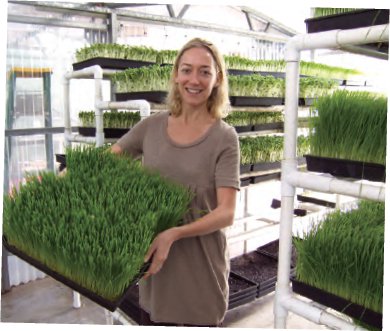
He’s the best grower in the country and will teach you a ton about sprouting, too. In the age of online shopping, you can get trays of fresh wheatgrass shipped right to your door. To enjoy DIY wheatgrass juice at home, you’ll need a twin-gear juicer or a not-so-fancy hand-crank model. That’s what I use—it’s a little plastic job that I got for $28—great for travel and easy to clean. Go to healthyjuicer.com for more deets.
BLEND, BABY, BLEND
Another great way to get liquid nutrition is to blend your fruits and veggies into delicious green smoothies. They’re easy to make, take little prep and cleanup time, and require only one piece of kitchen equipment—a blender! The difference between a juice and a smoothie is that a smoothie leaves no pulp behind—it contains all the fantastic fiber of the ingredients. The tough cellulose structure of the produce is broken into tiny pieces that are easy for your body to digest and assimilate.
Think of it as a pre-chewed blast of optimum nutrition. Smoothies balance pH and blood sugar while the fiber assists in sponging up toxins. You can load them up with good fats, quality vegan protein powders (see supplement chapter), and ground flax, chia, or hemp seeds. Smoothies are more filling and provide more energy. On days when I want rich and creamy emotional comfort, I blend, baby, blend!
There are a million ways to make a smoothie and even more recipes online. I call my enlightened fave “the Green Guru.” It’s like wisdom in a glass! The guru’s ingredients are really simple: avocado, coconut water (or purified water), cucumber, romaine, pear or banana, a dash of stevia (or agave), a wee bit of cinnamon or cacao, and 1 to 2 ounces of E3Live (see chapter 9 for more on this supplement).
When building your smoothies, it’s best to use the same 3:1 (veggie to fruit) ratio as described for juice. Berries are a good low-glycemic choice in the summer (put ’em in the freezer for added pizzazz). Sweet pea or sunflower sprouts are electric—they’re loaded with oxygen and protein. Other lovely leafy options include spinach, kale, and red lettuce.
BLENDER BARGAINS
Now that you’ve got the blending scoop, do you have the right tools? Like most people, I had an old hand-me-down blender from my mom’s disco daiquiri days. You know the one—cracked pitcher, missing buttons, and a motor with the power of a nose hair trimmer. I didn’t know what I was missing until I got serious about green smoothies. I now use a Vita-Mix, the Cadillac of blenders. This sucker could pulverize a cowboy boot! I use it to make the creamiest smoothies, soups, puddings, dressings, sauces, and occasional (killer!) margarita. The only drawback is the price: anywhere from $340 to over $600, depending on the model. But it’ll be the last blender you ever buy! Snag one when you get a little financial breathing room.
The Blendtec is another powerful high-end brand. They’re slightly less expensive, starting at around $230 and going up to $600. Among smoothie aficionados there are those in the Vita-Mix camp and others firmly planted in the Blendtec camp—it’s up to you to decide. Always do research, read consumer reviews, and Internet- and comparison-shop for the best deals.
As for moderately priced blenders, Breville has three models ranging from $150 to $300. Waring’s MBB518 Pro is less than $200 and gets user kudos for strength and durability. KitchenAid’s five-speed, 56-ounce blender is less than $100 and earns high marks. And at around $65, the Oster Classic Beehive is a stylin’ bargain.
JUICING
VERSUS BLENDING
Is juicing better than blending?— I recommend including both in your weekly repertoire. Both are terrific, but juice gives you instant energy while smoothies take a bit longer to assimilate and require more work from your body. Personally, I juice more than I blend. In an average week I’ll juice four to five days and enjoy smoothies for the remainder. Juice makes me feel lighter and more hydrated first thing in the morning. Breakfast literally means “to break a fast” and I prefer to do that with juice. It allows my body a longer process of cleansing and repair.
But I don’t want to give green smoothies a bad rap. They are definitely more filling and stick with you longer, plus they take less time to make. They’re also an easier sell to skeptics. In 2009 I went to New Orleans to care for displaced female survivors of Hurricane Katrina with my friends from the Urban Zen Foundation. We spent three days in the Superdome as part of Eve Ensler’s ten-year V-day anniversary. The stadium was transformed into SUPERLOVE—a place to heal, celebrate, and activate through yoga, massage, healing circles, makeovers, and more.
I made smoothies—anywhere between 5,000 and 7,000 cups of liquid love! The SUPERLOVE recipe was really simple: cucumber, watermelon, a sprig of mint, a dash of agave sweetener, and ice. Normally, I wouldn’t add sweetener to a recipe like this, but the fabulous gals of the Big Easy were used to sugar and spice and everything not so nice. As a result, many of them had serious health issues.
My goal was to teach the women that real fruits and veggies can be delicious. If added sweetener could help me do it, amen! In the end I was surprised at the number of ladies who came back for seconds and thirds. I highly doubt I would have nabbed so many skeptics with a dark green glass of juice. The moral of this story is that luscious smoothies can be the sneaky little helper you need to get your friends and family to embrace healthy libations.
The bottom line: Do what works best for your majestic self (and your schedule). Including liquid nutrition, in whatever form, will change your life. Juice, blend, sip, somersault. Got it?
FASTING
Fasting is nature’s surgical table. It’s also a ticket to the divine. Fasting affects you on every level—physical, mental, emotional, and spiritual. This ancient practice has a long history in culture and religion. But like many time-honored wisdoms that have been bleached from our society, fasting gets a bad rap these days. It’s considered either a fad, new agey, or dangerous. But we can look to the animal kingdom to learn the truth about the “dangers” of fasting.
When my super-pooch Lola gets a bellyache from sneaking rotten treats from the garbage or dining on deer turd, she doesn’t call up the vet or head to the drugstore. She fasts by drinking water and chewing grass and is feeling better posthaste. Quite frankly, I’d rather take a page from her healing manual than get sucked into the medical system of endless pills, bills, and insurance bullshit.
Fasting should never equal starvation, deprivation, or restriction. Fasting is simply resting from solid food. You’ll still be receiving an enormous amount of nutrition (and oxygen!) in liquid form. Fasting gives your body a break from spending the enormous amounts of energy required to break down food—especially the high quantities of junk in the Standard American Diet—and allows you to redirect that energy toward healing and detoxification. While fasting, you release toxins stored in your colon, liver, lungs, bladder, sinuses, skin, and kidneys, allowing your body to function better.
On my 21-Day Plan (see chapter 10), I recommend fasting one day per week. I base my protocol on personal experience and what I learned during my health educator training at the Hippocrates Health Institute. In his book Living Foods for Optimum Health, Dr. Brian Clement, director at Hippocrates, says, “Fast one day every week, consuming only freshly squeezed green drinks, vegetable juices, purified water, herbal teas. These fasting days will allow any potential long-term toxins to be released before they can cause serious damage. It’s like changing the oil in your car before your engine fails.”
Do you need to fast in order to cleanse your body? No, at least not at first. Depending on your current diet, abstaining from meat, dairy, processed sugars, and starches while adding alkaline food and drink may be all you need to help eliminate the garbage in your system. Once you’ve leaned into a better diet, then you can kick it up a notch with a fast. If you go from 0 to 60 too quickly, you may find the experience overly intense (more on detox symptoms in a jiffy). Fasts are not a quick fix or a magic bullet. You know how I feel about those—they don’t work! You’ll fall flat on your face and gain the weight or dis-ease back. Are we on the same page? Fasting only works in conjunction with a better overall diet that’s consumed on a consistent basis.
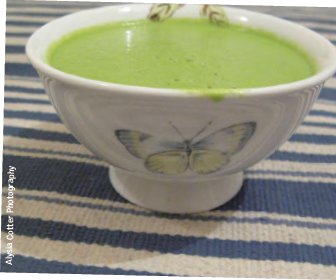
Fasting only works in conjunction with a better overall diet that’s consumed on a consistent basis.
A DAY IN THE LIFE OF A HEALTHY FAST
Hydrate, nourish, hydrate! This is the mantra for a healthy fast. Drink lots of green nourishment, purified water with lemon and herbal teas. When I fast, I drink about 64 to 92 ounces of fresh, organic green juice—about 16 ounces at each sitting. This may be too much for you. If your fast includes smoothies, you probably won’t need as many ounces since smoothies are bulkier than juices. Just make sure you get enough and that you’re not too hungry. A little pang is fine, but no meltdowns! If your belly gurgles, drink more water or have a cup of herbal tea. After twenty-four hours, ease out of the fast with a green smoothie or a blended raw soup made with veggies, herbs, and spices.
A teaspoon per serving of good fat—such as hemp, flax, or olive oil—makes soups rich and creamy. If you prefer, you can use half an avocado instead of oil. Some people find raw soups to be more palatable if they’re slightly chilled (see the recipes in chapter 10 for ideas and inspiration). If you prefer warm soups, blend them in your Vita-Mix until the veggies start to heat up. This rapid stirring raises the temperature a bit without losing many nutrients. You can also warm your soup slightly on the stove. Use your finger as a thermometer. If the soup’s too hot for your digit, it’s too hot for you (and the enzymes, vitamins, minerals, etc.)!
The ingredients used in my simple sexy juice fast can vary; you don’t need to stick to them exactly. Just as in life, variety is the spice that makes us sing. So switch your recipes around to avoid mindbending boredom, screaming at public utility workers, or grand theft auto! Drink as much as you like and remember to not only change the menu to suit your palate, but rotate your veggies to make sure you’re getting all your vitamins and minerals.
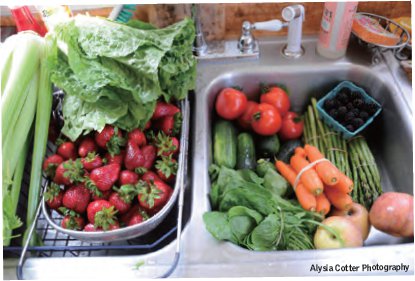
A SIMPLE 
ONE-DAY
JUICE FAST
7 A.M.: 8 ounces water with lemon and a pinch of cayenne. This cleanses your liver and stimulates circulation. If you like, sip your favorite herbal tea throughout the day.
8–9 A.M.: 16 to 20 ounces of green juice: cucumber, celery, broccoli stems, kale, romaine, one pear, ½-inch piece of gingerroot.
II A.M.: Midmorning pick-me-up: 16 to 20 ounces of green juice.
I P.M.: Lunch. You guessed it—16 to 20 ounces green juice.
4 P.M.: Afternoon delight. Oh my, what could it be? 16 to 20 ounces green juice. If possible, also suck back a 2- to 4-ounce shot of wheatgrass!
6–7 P.M.: For dinner, you can continue with just juice, a smoothie, or blended raw soup. If you’re feeling too uncomfortable or prefer to ease out of your fast with solid food, have a light salad or some gently steamed veggies with a little olive oil and sea salt or a bowl of miso soup with wellchopped greens and scallions.
FALLOUT: WHAT TO EXPECT
WHEN YOU’RE JUICED
Though you will be drinking lots of green nutrition, don’t be surprised if you hit a few icy patches. The more toxins you’ve accumulated, the more you’ll have to eliminate. Detox symptoms occur because toxins are leaving the cells and tissues faster than the body can eliminate them, and for many that can spell discomfort and a lot of toilet time. This is natural, but if it gets too intense you can easily dial it down. Folks living on McDonald’s, Dunkin’s, and Doritos might have a lot of discomfort as the demons exorcise.
In all honesty a one-day fast shouldn’t cause too much drama. Uncomfortable symptoms are a bigger problem on longer fasts. That said, expect some mucus, skin eruptions, headaches, stinky gas, a thick white coating on the tongue, and fatigue. You may even experience some nausea. Once you get over the healing hump, you will feel much better. When symptoms arise, remember to drink lots of water to help flush you out.
Here’s something else to remember: Poisons drain your energy. When you release them, you also release their patterns—including the mental, emotional, and spiritual chaos they cause. Emotional swings are common during juice cleansing—yes, even within a twenty-four-hour period. As with the physical symptoms, grab a box of tissues and ride them out.
It’s also a good idea to follow a fast with an enema (or a colonic) to keep the pipeline clear, allowing for better evacuation going forward. For a good sweat, sit your cute butt in the sauna, too! If you think fasting is too extreme for you, then honor that feeling. But I ask you to pause for a moment and consider what many of us deem normal—gallstones and gallbladder removal, blood pressure medicine, insulin pumps, debilitating arthritis, steroids, and other medical miseries. A plant-based diet and some periodic housekeeping seem pretty easy to me!
 TIP
TIP
An important tip for long-term fasters: Failure to maintain your electrolytes can be dangerous. However, the solution is simple: Add a pinch of sea salt to your juice, or make sole and drink the salt water.
LONGER FASTS
Some folks do longer fasts, but keep in mind that longer is not always better. Long-term fasting must also be accompanied by regular colonics. My longest green drink fast was twenty-one days. It was a detox dump-a-thon! My liver deep-sixed garbage, my lymph yacked, and my butt exorcised the demon. As my colon hydrotherapist said, “Here come the mummies!” But it was also a physical and emotional roller coaster.
My energy level went up, down, and back up again. Ultimately there were definite pluses and it served me well, but I do not recommend a longterm fast for most people, especially without expert supervision. Particularly because you really have to be careful about electrolyte imbalance and how you come off the fast. I’ve seen a few fasting enthusiasts replace one addiction for another. This isn’t a marathon and there’s no such thing as ultimate purity. In fact, let’s not forget that stressing about perfection is as bad as booze, cigs, animal toes, and white crap.
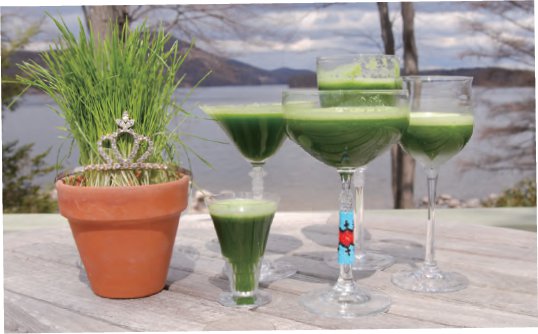
Some people should avoid fasting. If your current health is too weak or if you have an eating disorder, are underweight, or are being treated for a chronic disease such as cancer, if you have heart problems or are pregnant or lactating, fasting of any kind is not recommended. Also, children should never fast. Be realistic and honest. If you have any concerns, check with your doctor. Water fasts are not recommended. Water fasting will dump far too many stored poisons into our bloodstream at a rate that most of us simply cannot tolerate. The same goes for those popular water, maple syrup, cayenne, and vinegar fasts—that ain’t nutrition.
WATER
Drinking purified water is like giving your insides a bath, a good rinse, a happy shower. Refreshing! Besides, water is the best drink to quench your thirst—if you can get off the diet pop kick and replace it with water, you’ve accomplished a great deed. Our bodies are made up of over 70 percent water. Your brain is roughly 80 percent water. Remember, you’re electric—when your cells don’t have enough fluid, they lose their conductivity. Water helps nutrients flow into our cells and acid wastes flow out. Water is the main component of blood and lymph. It regulates body temperature. Water is absolutely essential to good health. Because we lose nearly 3 quarts a day through respiration, sweat, and urine, it’s important to replenish daily.
Ideally, we should be consuming half our body weight in ounces of pure water each day. For example, a 140-pound person should drink 70 ounces (about nine 8-ounce glasses) throughout the day. It may seem like a lot, and certainly when you’re juicing on a regular basis, drinking herbal teas, and eating lots of raw veggies, you don’t need as much. To keep up with the demands of your inner ocean, it’s best to pace yourself and sip throughout the day without waiting to feel thirsty. By the time you feel the sensation of thirst, you’re already dehydrated. And hunger is often just a sign of thirst.
Oh, and guess what? Coffee is not water. Neither is black tea, soda, bottled juice, “vitamin water,” or bullshit Red Bulls. These beverages actually pull water (and minerals) from your body. Don’t have any illusions that you’re quenching your thirst when you drink them.
Can you overdo it? Yes. If you act like a frat boy in a hazing ritual and chug an insane amount of water all at once, you can develop what’s called water intoxication, also known as hyponatremia. It’s extremely rare, with most cases occurring to overheated athletes. The point is, don’t go crazy—just stay hydrated with moderate amounts of water at regular intervals.
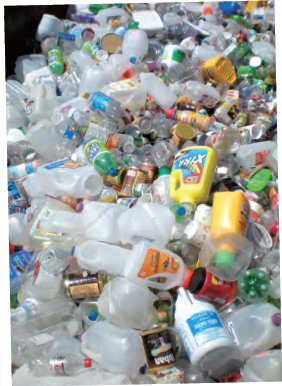
BOTTLED WATER: JUST SAY NO
Although it’s oh-so-convenient to buy bottled water, it’s also a catastrophic waste on so many levels. Untold millions of plastic bottles clog our bloated landfills every year, and since space is extremely limited, we end up shipping our mountains of garbage to developing countries or simply dumping it far out to sea. Pound for pound, plastic bottles are one of the most ubiquitous forms of trash that pollute our oceans, rivers, roadways, and parks. Plastic bottles can last hundreds or even thousands of years. In turn, marine life and birds mistake plastic litter for food and end up choking and dying in droves.
If I haven’t already gotten your attention, this might: That fancy $3 bottle of water is often nothing more than tap water. In fact, according to Food and Water Watch (foodandwaterwatch.org), tap water is actually better overall than most bottled water. The bottled water industry is subject to minimal regulation and oversight, and most bottling plants go uninspected for years on end. While the labels show serene and reassuring images of mountain glaciers and tropical waterfalls, you actually might just be guzzling from a big-city spigot or a hole drilled down the road from God-knows-what Superfund site.
Popular brands may contain the same toxic chemicals, pesticides, and pathogens that occur in tap water. And because the bottles aren’t always sterilized before filling, that supposedly “clean” product could have nasty fungi and bacteria growing in it. Hey, did I mention that most bottled waters are acidic? It’s true—many of the most popular brands test at a pH of around 5 or 6. Ultimately, you’re spending up to 1,000 times more per gallon for bottled water than tap water.
Of course, if you’re in a pinch it’s best to stay hydrated by buying a bottle than to go without. But if you can make a modest investment in a water filter and a reusable stainless-steel bottle, like a Kleen Kanteen, then do yourself and the planet a favor and buy them. Stay away from the reusable hard plastic bottles. They contain dangerous chemicals known as BPAs, which can wreak havoc on our hormones. (Many other products contain BPAs, including baby bottles and food containers. Federal and state laws are beginning to restrict their use, but for now, it’s best to stay vigilant. These plastics can usually be identified by RECYCLE #7 printed on the bottom.)
FILTERED WATER TIPS
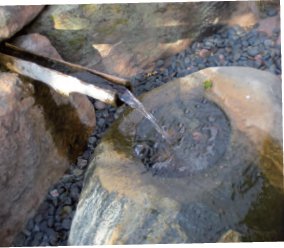
 Change filters periodically according to manufacturer’s recommendations. A dirty filter not only doesn’t work but can actually add impurities to your water. Mold likes carbon filters.
Change filters periodically according to manufacturer’s recommendations. A dirty filter not only doesn’t work but can actually add impurities to your water. Mold likes carbon filters.
 Filtered water doesn’t keep—refrigerate or use it soon after filtration. The nasty critters will grow back quicker than usual now that the chlorine has been removed.
Filtered water doesn’t keep—refrigerate or use it soon after filtration. The nasty critters will grow back quicker than usual now that the chlorine has been removed.
 Fill ice cube trays with filtered water. Your cocktails (virgin or slut) will taste sooo much better.
Fill ice cube trays with filtered water. Your cocktails (virgin or slut) will taste sooo much better.
 Rinse your fruits and veggies, and soak your nuts and seeds in filtered water.
Rinse your fruits and veggies, and soak your nuts and seeds in filtered water.
 If you’re in the middle of cancer treatments like chemo and radiation, you may want to use foodgrade hydrogen peroxide (FGHP) to soak and clean your veggies.
If you’re in the middle of cancer treatments like chemo and radiation, you may want to use foodgrade hydrogen peroxide (FGHP) to soak and clean your veggies.
FILTRATION METHODS
Almost all home water filtration systems use one of these two types of filters:
• Activated carbon filters. These work by passing water through tiny grains of charcoal, which attract and remove particulates. This system is effective on chlorine and most organic matter, but misses certain tiny chemical compounds, fluoride, and most metals.
• Reverse osmosis (RO) filters. These force water through a membrane that has extremely small holes—about one millionth the width of a human hair. This removes almost every dissolved solid, including many toxic chemicals. It’s a slow process and wastes a lot, since only about 10 percent of the water entering the system makes it through.
PURE WATER AT HOME
Compared to many poor countries in the world, the tap water in the United States is definitely better, but don’t think it’s completely safe. According to a 2009 New York Times study, more than 20 percent of municipal water treatment systems violated key provisions of the Safe Drinking Water Act in the previous five years, exposing tens of millions of people to unsafe water. Keep in mind that this act only regulates 91 out of more than 60,000 chemicals in use in the United States.
A typical glass of tap water might contain a rogue’s list of frightening things that shouldn’t be there: heavy metals, industrial solvents, pesticides, rocket fuel, and even pharmaceuticals your neighbors peed down their drains in the past. The chlorine that is put in the water to kill germs is itself controversial, because it also kills your intestinal flora. For the millions of homes relying on well water, unfortunately the story isn’t much different (except for the chlorine).
What to do? Install a water filter. While no filter guarantees absolutely purity, they can be a great improvement. Different types of filters remove or reduce different types of impurities. To figure out what you need, learn about your water first. Start by requesting your community’s annual waterquality report, available from the utility or from your local health department. You should also test the water from your tap, since it may have picked up junk on its journey to your sink. Your local health department or an independent lab can do it for free or for a small fee.
Next, you’ll want to consider which water you want to filter. Drinking only? Or cooking, bathing, and laundry as well? For most households, I recommend using filtered water at least for drinking and cooking. But keep in mind that your skin is your body’s largest organ and you absorb many substances through it, so if you can filter your bathing water as well, brava! For maximum filtration, a whole-house system can be installed. These usually connect to the main pipe shortly after it enters the house and can be hidden out of sight in a basement or closet. For kitchen use only, there are smaller, under-sink models.
Filtration systems range in price from about $60 on up to $400 or more, and should be installed by a plumber—or that sexy somebody who’s handy with tools. Finally, the simplest and cheapest way to treat drinking water is to buy a pitcher that contains a filter. Wellness Carafe, Brita, and Pur are three popular brands.
There is some debate about whether it’s better to drink water that contains minerals or water that has been purified and the minerals removed. Trace amounts of essential calcium, magnesium, and sodium have been flowing in our mountain streams and nourishing us forever. So assuming you can still find clean, natural water, there’s nothing wrong with it. But compared with your food, drinking water delivers only a tiny fraction of these important minerals. It’s no big deal if you drink purified water, so long as you’re also eating a healthy diet. Reverse osmosis and distillation are two common filtration methods that remove minerals. They can be remineralized with a pinch of quality sea salt.
A word of caution about distilled water: It’s not as pure as commonly believed. In fact, any chemicals with a boiling point below water are not removed. This includes chlorine and many insecticides and herbicides.
IONIZED WATER
Some filter systems can also ionize the water—that is, use electrolysis to break the water into acid and alkaline portions. There are household uses for both. Acid water is good for washing veggies, as well as skin, hair, and brushing teeth, while alkaline water is good for juicing, cooking, and drinking. In the body alkaline water is said to help eliminate acid waste, balance pH, and act as an antioxidant by mopping up free radicals. Countertop and under-sink ionizing devices are widely available online. These units are fairly expensive ($1,000 to $3,000), but keep in mind they also contain carbon filters, so in a sense you’re getting two filters for the price.
One last thought. If you don’t filter your water, your body will—and your liver and kidneys will be very unhappy about it. Don’t make them put in overtime. They need beauty sleep just like you, my lovely.
DRINKING BUDDIES
I’m a juicehead all right; I love my Green Goddess morning, noon, and night. I love to hydrate with clean, healing water. Let’s be drinking buddies and (faux) egg each other on. You always drink more when you do it with a friend. How about enlisting a few other like-minded ladies (or gents) to swap recipes, check in to make sure you’ve met your daily goal, or just to toast to the new yous!
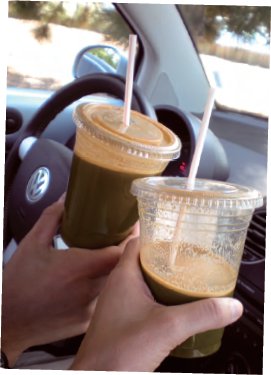
 testimonial: Ryan R.
testimonial: Ryan R.
The Crazy Sexy Diet launched me into a fantastic journey. I had been struggling with a variety of issues that evolved during my radiation treatments last summer. The diet appealed to me because I was frustrated with not feeling like myself (a strong, nutritionally balanced, confident, vegetarian mother of four, wife, and science teacher). One major issue that I have suffered is with my voice. It has been hoarse or absent since I started radiation last June.
The daily juice and mostly raw diet has vastly improved the quality and strength of my voice. I am convinced that hydration is a major part of my voice issue. My radiologist insists that my voice issues can’t be related to my treatments; however, in addition to laryngitis/severe hoarseness, I was incredibly thirsty from day one of radiation and tamoxifen. No amount of water intake quenched my thirst. The radiation ended in early August and I quit taking the tamoxifen in November.
Although I had been a vegetarian and had juiced vegetables regularly over the last thirty-plus years, I had never considered making green juice. Today, thanks to CSD, green juice is a major component of my daily diet. Cucumber is the base of my daily green breakfast cocktail. My dehydration issues are finally resolved! I am hopeful that with speech therapy my voice will recover. My diet is evolving toward vegan and I feel very well. I no longer fear the return of the cancer. I am confident that my improving diet will help me maintain my health.
CHAPTER  IN REVIEW
IN REVIEW
REMEMBER:
 Have a juice first thing in the morning.
Have a juice first thing in the morning.
 Get the best juicer you can afford—you want something sturdy, because you’re going to use it a lot.
Get the best juicer you can afford—you want something sturdy, because you’re going to use it a lot.
 Suck back a 2-ounce shot of wheatgrass on a regular basis.
Suck back a 2-ounce shot of wheatgrass on a regular basis.
 Blend, baby, blend—add smoothies into your repertoire for great meals on the go or healthy snacks.
Blend, baby, blend—add smoothies into your repertoire for great meals on the go or healthy snacks.
 Partake of a twenty-four-hour juice fast—once a week or once a month or once per season.
Partake of a twenty-four-hour juice fast—once a week or once a month or once per season.
 Hydrate! Sometimes we mistake hunger for thirst.
Hydrate! Sometimes we mistake hunger for thirst.
 If you don’t filter your water, your body will.
If you don’t filter your water, your body will.